Measuring System-Level Impacts of Corporate Mobility as a Service (CMaaS) Based on Empirical Evidence
Abstract
1. Introduction
- Identify Key Performance Indicators (KPIs) to evaluate the impacts of CMaaS.
- Develop a system-level evaluation framework that can show the interactions among individual, company, and societal levels with the intention of providing feedback to the companies.
- Apply this system level evaluation framework to a CMaaS pilot to gain insight into the impacts of a CMaaS system.
2. State-of-the-Art
3. Methodology
3.1. Selection of KPIs
3.2. Definition of Evaluation Framework
3.2.1. Framework at the Individual Level
3.2.2. Framework at the Company Level
3.2.3. Framework at the Societal Level
3.2.4. Framework at the System Level
3.3. The MaaS Pilot
4. Evaluation Results
5. Discussion and Conclusions
- (1)
- The system level impacts of CMaaS evaluated by the framework could support the companies in making better decisions based on the positive and negative impacts for adopting and implementing the service system.
- (2)
- When combined with travel incentives provided by the company, CMaaS has the potential to improve the commuting experience for employees traveling to, from, and within work.
- (3)
- The identified KPIs and the system level framework can be modified and applied to various corporate settings and can be generalized to other MaaS impact evaluations.
- (4)
- With support of good data for the KPIs chosen, the framework could be used in various other corporate contexts as well as other type of MaaS impact evaluation in general.
Author Contributions
Funding
Conflicts of Interest
References
- Lam, A. The Countries with the Longest and Shortest Commutes. Available online: https://daliaresearch.com/blog/the-countries-with-the-longest-and-shortest-commutes/ (accessed on 17 December 2019).
- van Doorn, L.; Arnold, A.; Rapoport, E. In the Age of Cities: The Impact of Urbanisation on House Prices and Affordability. Hot Prop. 2019, 3–13. [Google Scholar] [CrossRef]
- Abedin, N.; Kamau, J.; Hossain, M.I.; Maruf, R.I.; Fukuda, A.; Ahmed, A. A Case Study to Design a Mobility as a Service Model for Urban Female Corporates to Improve Their Work Performance. In Proceedings of the TENCON 2017-2017 IEEE Region 10 Conference, Penang, Malaysia, 5–8 November 2017; pp. 1445–1450. [Google Scholar] [CrossRef]
- Gilibert, M.; Ribas, I.; Rodriguez-Donaire, S. Study of On-Demand Shared Ride-Hailing Commuting Service: First Results from a Case Study in Barcelona. WIT Trans. Built Environ. 2019, 182, 121–128. [Google Scholar] [CrossRef]
- Ma, L.; Ye, R. Does Daily Commuting Behavior Matter to Employee Productivity? J. Transp. Geogr. 2019, 76, 130–141. [Google Scholar] [CrossRef]
- Olsson, L.E.; Gärling, T.; Ettema, D.; Friman, M.; Fujii, S. Happiness and Satisfaction with Work Commute. Soc. Indic. Res. 2013, 111, 255–263. [Google Scholar] [CrossRef] [PubMed]
- Laine, A.; Lampikoski, T.; Rautiainen, T.; Bröckl, M.; Bang, C.; Poulsen, N.S.; Kofoed-Wiuff, A. Mobility as a Service and Greener Transportation Systems in a Nordic Context; Nordic Council of Ministers: Copenhagen, Demark, 2018. [Google Scholar] [CrossRef]
- Hesselgren, M.; Sjöman, M.; Pernestål, A. Understanding User Practices in Mobility Service Systems: Results from Studying Large Scale Corporate MaaS in Practice. Travel Behav. Soc. 2019, 21, 318–327. [Google Scholar] [CrossRef]
- Jittrapirom, P.; González, A.; Caiati, V.; Feneri, A.; Ebrahimigharehbaghi, S.; Alonso, M.J. Mobility as a Service A Critical Review of Definitions, Assessments of Schemes, and Key Challenges. Urban Plan. 2017, 21, 13–25. [Google Scholar] [CrossRef]
- Heikkilä, S. Mobility as a Service—A Proposal for Action for the Public Administration Case Helsinki. 2014. Available online: https://aaltodoc.aalto.fi/handle/123456789/13133 (accessed on 17 December 2019).
- Hilgert, T.; Kagerbauer, M.; Schuster, T.; Becker, C. Optimization of Individual Travel Behavior through Customized Mobility Services and Their Effects on Travel Demand and Transportation Systems. Transp. Res. Procedia 2016, 19, 58–69. [Google Scholar] [CrossRef]
- Ho, C.Q.; Hensher, D.A.; Mulley, C.; Wong, Y.Z. Potential Uptake and Willingness-to-Pay for Mobility as a Service (MaaS): A Stated Choice Study. Transp. Res. Part A Policy Pract. 2018, 117, 302–318. [Google Scholar] [CrossRef]
- Johansson, M. Mobility as a Service: Exploring Young People’s Mobility Demands and Travel Behavior. 2017. Available online: https://www.diva-portal.org/smash/get/diva2:1148201/FULLTEXT01.pdf, (accessed on 17 December 2019).
- Karlsson, M.; Akram, A.; Fallahi, S.; Sarasini, S.; Zhao, X. A National Approach to Assessing the Impacts of Mobility-as-a-Service (MaaS). In Proceedings of the ICOMAAS. 2nd International Conference on Mobility as a Service, Tampere, Finland, 3–4 December 2019; pp. 357–365. [Google Scholar]
- Kerttu, J.; Rosqvist-Smidfelt, L.; Wendle, B. Konsekvenser Av Mobility as a Service; Trivector Services Inc.: Huntsville, AL, USA, 2016. [Google Scholar]
- Burrows, A.; Bradburn, J.; Cohen, T. Journeys of the Future- Introducing Mobility as a Service; Atkins: London, UK, 2015. [Google Scholar]
- Kamargianni, M.; Li, W.; Matyas, M.; Schäfer, A. A Critical Review of New Mobility Services for Urban Transport. In Transportation Research Procedia; Elsevier B.V.: Amsterdam, The Netherlands, 2016; Volume 14, pp. 3294–3303. [Google Scholar] [CrossRef]
- Li, Y.; Voege, T. Mobility as a Service ( MaaS ): Challenges of Implementation and Policy Required. J. Transp. Technol. 2017, 7, 95–106. [Google Scholar] [CrossRef]
- Wong, Y.Z.; Hensher, D.A.; Mulley, C. Emerging Transport Technologies and the Modal Efficiency Framework: A Case for Mobility as a Service (MaaS). In Proceedings of the 15th International Conference Series on Competition and Ownership in Land Passenger Transport (Thredbo 15), Stockholm, Sweden, 13–17 August 2017. [Google Scholar]
- Axelsson, J. FFI Strategic Initiative Systems-of-Systems for Smart Urban Mobility (SoSSUM); Trafikverket: Sweden, 2017; Available online: https://www.vinnova.se/globalassets/utlysningar/2018-00136/omgangar/ffi-sossum-program-description.pdf845879.pdf (accessed on 23 January 2020).
- Machado, C.A.; de Salles Hue, N.P.; Berssaneti, F.T.; Quintanilha, J.A. An Overview of Shared Mobility. Sustainability 2018, 10, 4342. [Google Scholar] [CrossRef]
- Utriainen, R.; Pöllänen, M. Review on Mobility as a Service in Scientific Publications. Res. Transp. Bus. Manag. 2018, 27, 15–23. [Google Scholar] [CrossRef]
- Söderberg, R.; Carlsson, P. Trötta på tågkaoset–nu sätter Ikea in egna bussar. Available online: https://www.svt.se/nyheter/lokalt/smaland/trottnade-pa-tagkaoset-nu-satter-de-in-egna-bussar (accessed on 23 January 2020).
- Helft, M. Google’s Buses Help Its Workers Beat the Rush. Available online: https://www.nytimes.com/2007/03/10/technology/10google.html (accessed on 23 January 2020).
- González, Á. Amazon to Launch Commuter Bus Service for Eastside Employees. Available online: https://www.seattletimes.com/business/amazon/amazon-to-launch-commuter-bus-service-for-eastside-employees/ (accessed on 10 December 2019).
- Hashim, R.; Haron, S.; Mohamad, S.; Hassan, F. Assessment of Campus Bus Service Efficacy: An Application towards Green Environment. Procedia-Soc. Behav. Sci. 2013, 105, 294–303. [Google Scholar] [CrossRef]
- BusinessWeek Research Services. The Impact of Commuting On Employees How Commuter Benefits Can Help; TransitCenter, Inc.: New York, NY, USA, 2008. [Google Scholar]
- Constellation. How Employee Commuter Benefits Attract and Retain Talent. Available online: https://blog.constellation.com/2019/06/25/commuter-benefits-energy-savings/ (accessed on 10 December 2019).
- Antcliff, K.R.; Moore, M.D.; Goodrich, K.H. Silicon Valley as an Early Adopter for On-Demand Civil VTOL Operations. In Proceedings of the 16th AIAA Aviation Technology, Integration, and Operations Conference, Washington, DC, USA, 13–17 June 2016. [Google Scholar] [CrossRef]
- Sochor, J.; Strömberg, H.; Karlsson, C.M. Implementing Mobility as a Service: Challenges in Integrating User, Commercial, and Societal Perspectives. Transp. Res. Rec. 2015, 2536, 1–9. [Google Scholar] [CrossRef]
- Varela, J.; Susilo, Y.; Jonsson, D. User Attitudes towards a Corporate Mobility as a Service. Transportation 2018, 1–27, Pre-print. [Google Scholar]
- Parker, J. Applying a System of Systems Approach for Improved Transportation. S.a.P.I.En.S 2010, 3, 2. [Google Scholar]
- Mukhtar-Landgren, D.; Karlsson, M.; Koglin, T.; Kronsell, A.; Lund, E.; Sarasini, S.; Sochor, J.; Wendle, B. Institutional Conditions for Integrated Mobility Services (IMS). Towards a Framework for Analysis. 2016. Available online: https://portal.research.lu.se/portal/files/28465662/Mukhtar_Landgren_et_al_2016_Institutional_conditions_for_integrated_mobility_services.pdf, (accessed on 23 January 2020).
- KOMPIS. KOMPIS-Kombinerad Mobilitet som tjänst i Sverige. Available online: https://kompis.me/ (accessed on 10 February 2020).
- Henning, T.; Essakali, M.D.; Oh, J.E. A Framework for Urban Transport Benchmarking; World Bank: Washington, DC, USA, 2011; Volume 78. [Google Scholar]
- Swan, W. An Introduction to Key Performance Indicators. Available online: https://constructingexcellence.org.uk/tools/frameworkingtoolkit/the-process/construction/key-performance-indicators/ (accessed on 20 June 2020).
- Djordjevic, B.; Krmac, E. Key Performance Indicators for Measuring the Impacts of ITS on Transport. In Proceedings of the ISEP 2016: 5th EAAP International Symposium on Energy and Protein Metabolism and Nutrition, Krakow, Poland, 12–15 September 2016. [Google Scholar]
- Tundys, B. Key Performance Indicators as Element of Assessment and towards the Development of Sustainable Mobility. In Proceedings of the 17th International Conference on Transport Science ICTS 2015, Portoroz, Slovenia, 21–22 May 2015; pp. 540–553. [Google Scholar]
- European Commission. White Paper European Transport Policy for 2010: Time to Decide. Comm. Eur. Communities 2001, 21, 1–179. [Google Scholar]
- European Commission Communication. A Sustainable Future for Transport: Towards an Integrated, Technology-Led and User-Friendly System; European Commission: Brussel, Belgium, 2009. [Google Scholar]
- European Communities-Commission. The Future Development of the Common Transport Policy. Eur. White Pap. 1992, 92, 454. [Google Scholar]
- Sveriges Riksdag. The Entire Journey All Year Round!–A Follow-up of the Accessibility of the Transport System for People with Functional Disabilities; Swedish Parliament: Stockholm, Sweden, 2013. [Google Scholar]
- Trafikverket. The Swedish Transport Administration Annual Report. 2017; pp. 1–104. Available online: https://trafikverket.ineko.se/Files/sv-SE/49148/Ineko.Product.RelatedFiles/2018_086_TRV_Annual%20Report_2017.pdf (accessed on 17 December 2019).
- Ringenson, T.; Arnfalk, P.; Kramers, A. Indicators for Promising Accessibility and Mobility Services. Sustainability 2018, 10, 2836. [Google Scholar] [CrossRef]
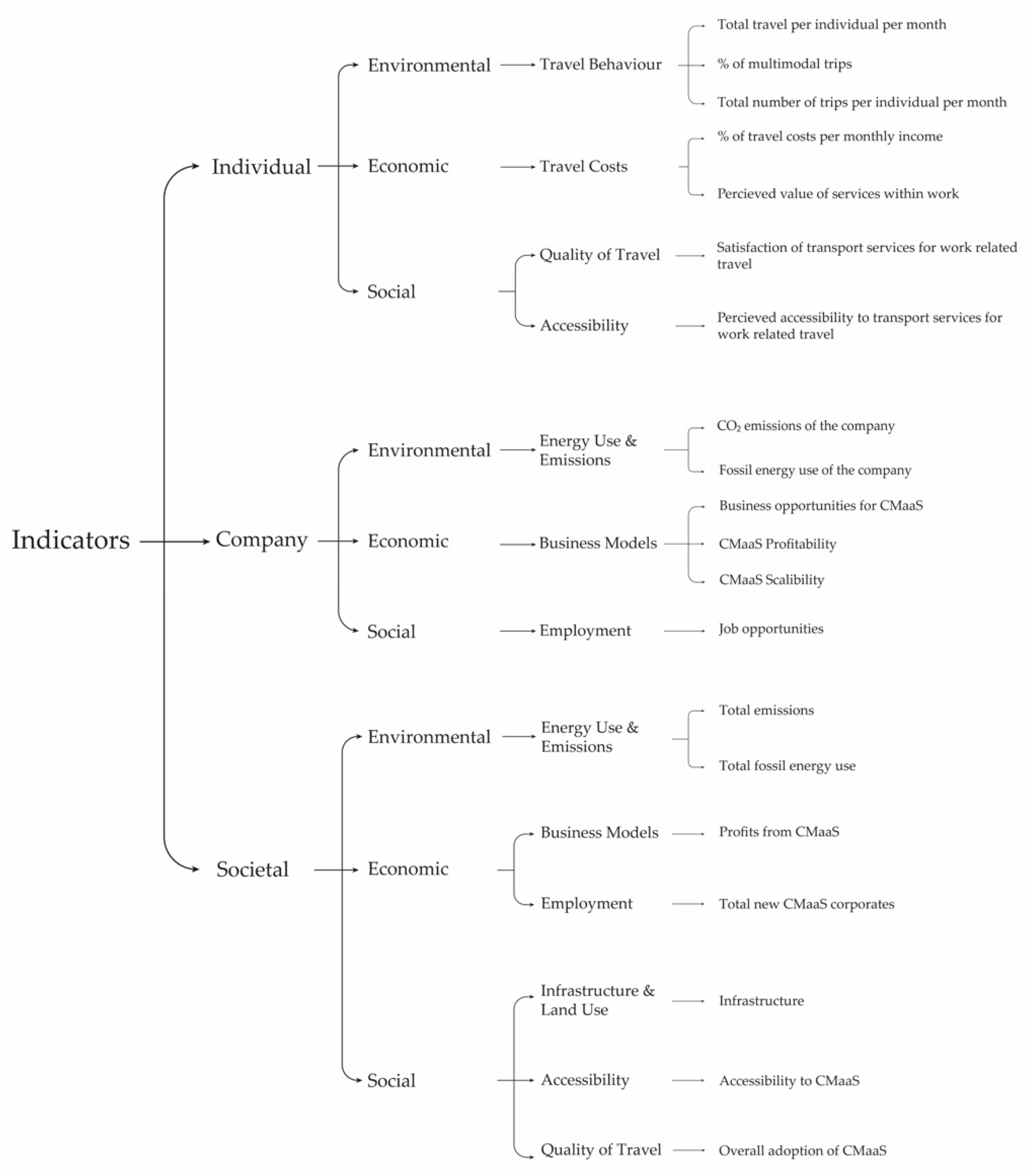
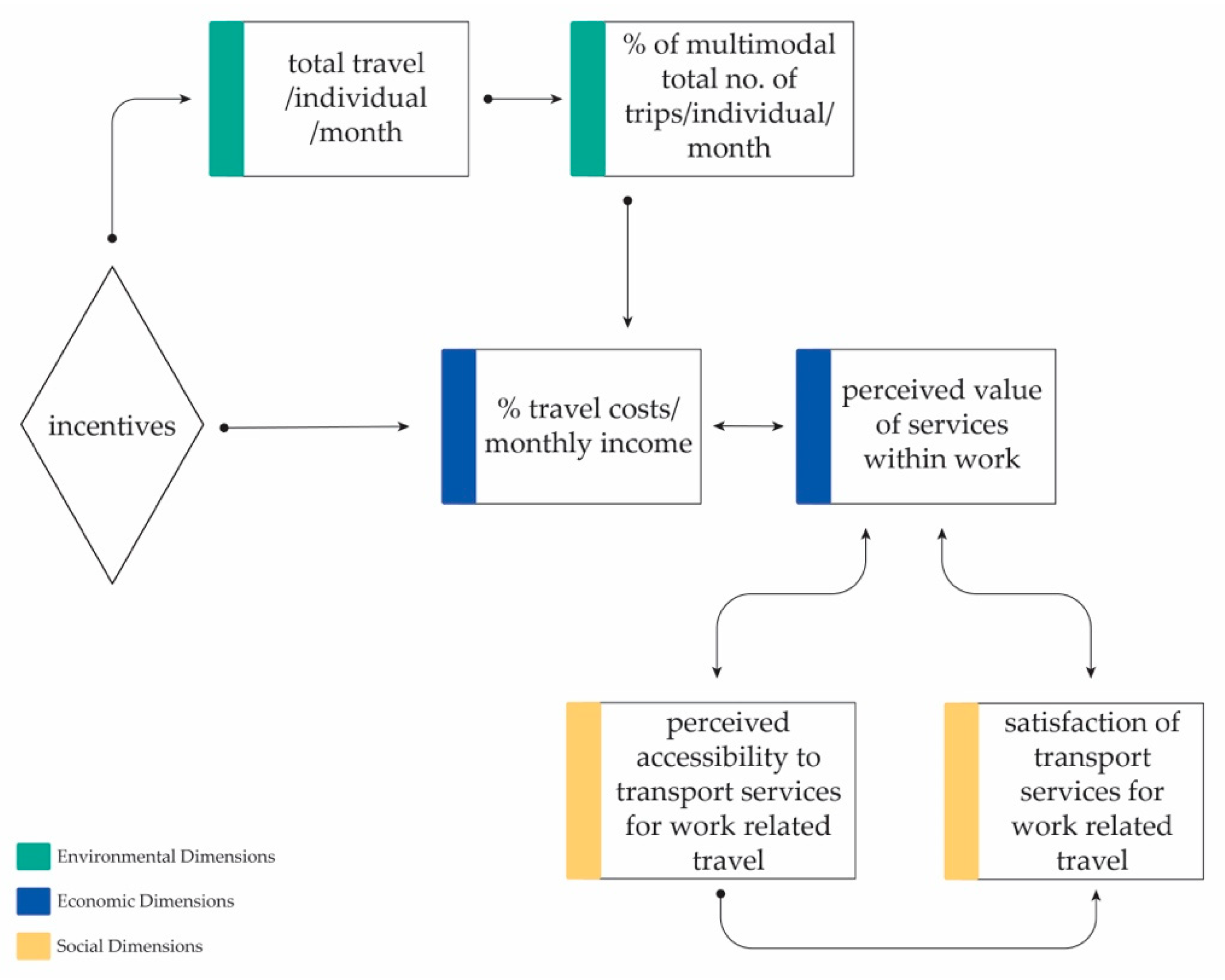
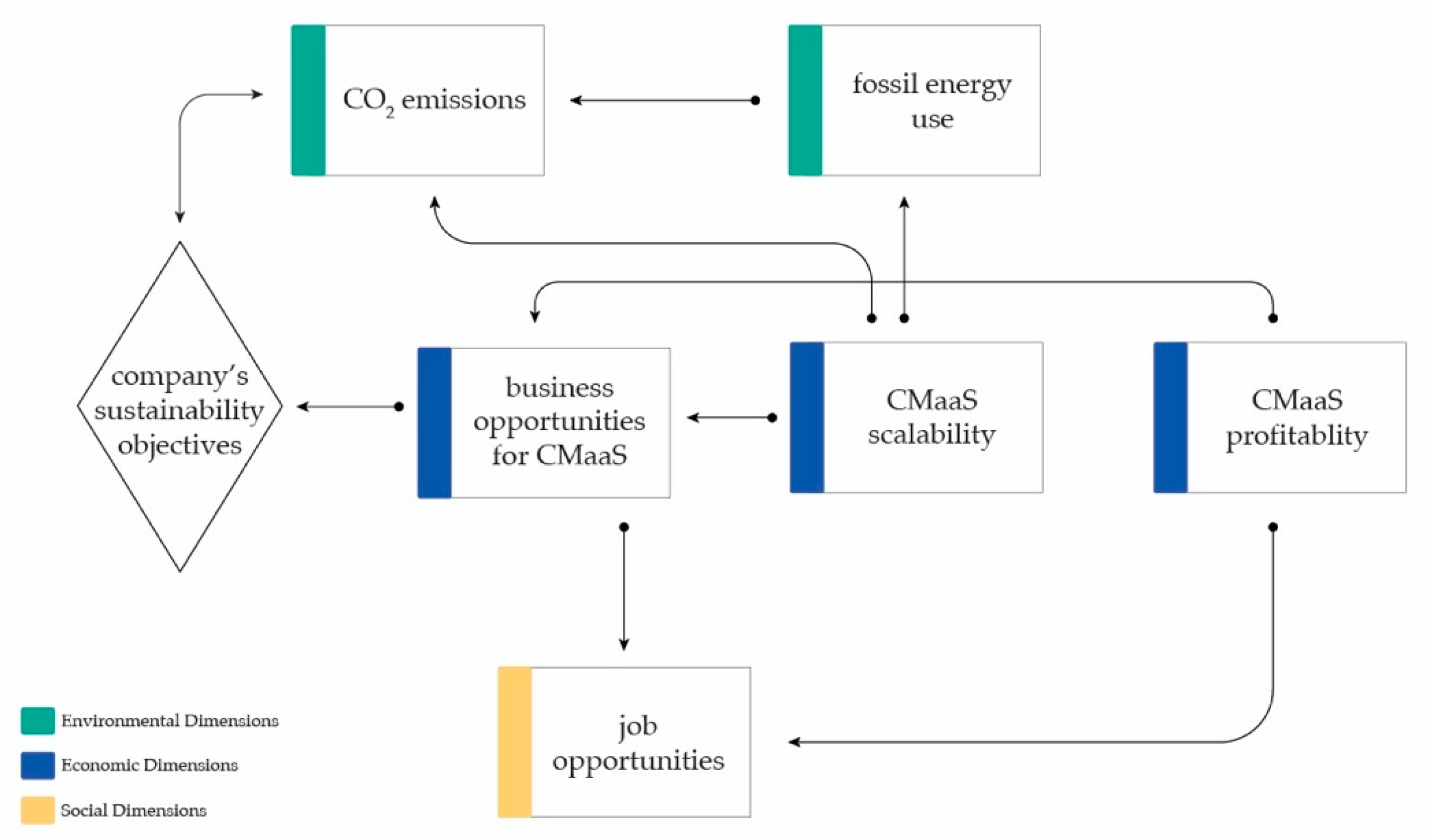
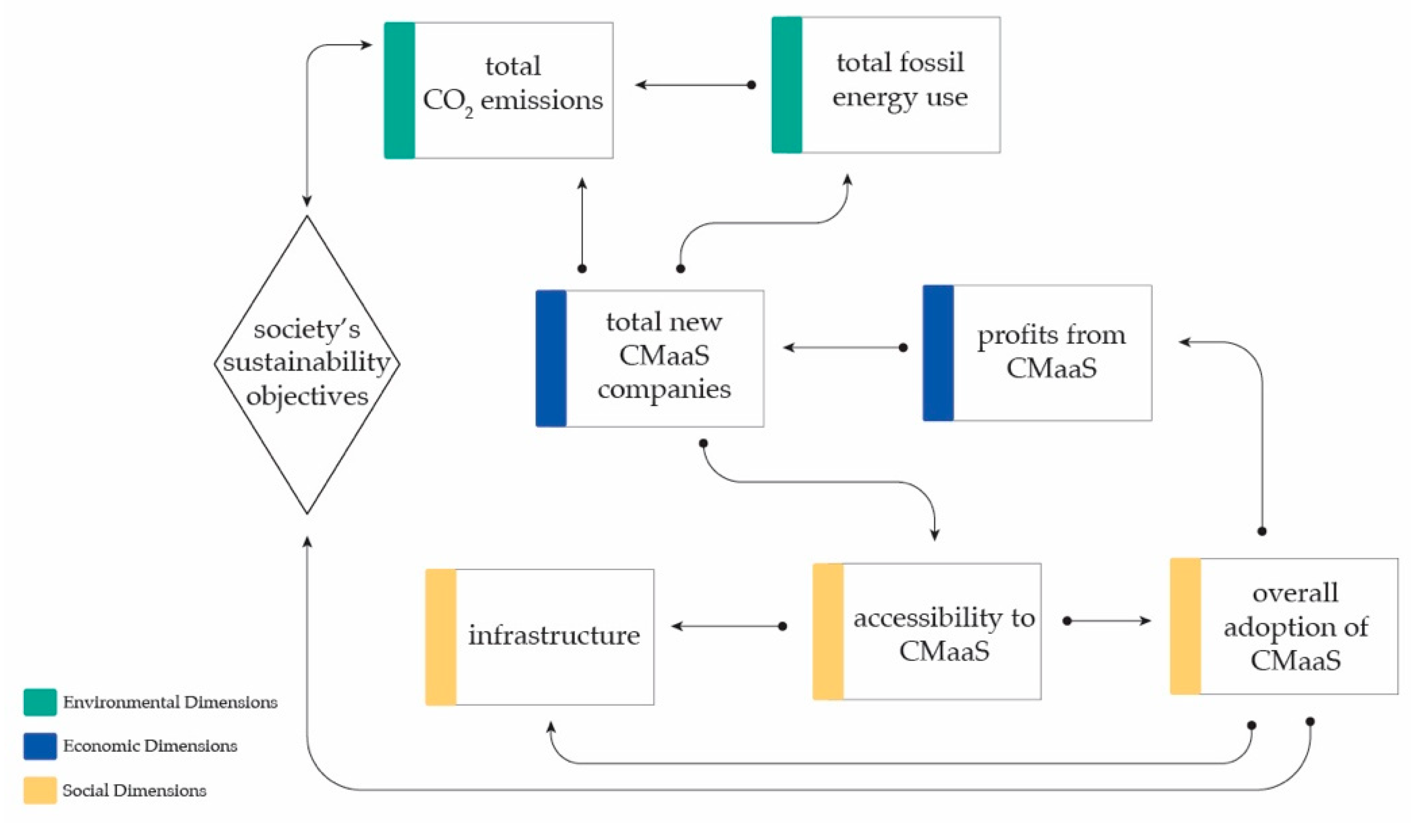
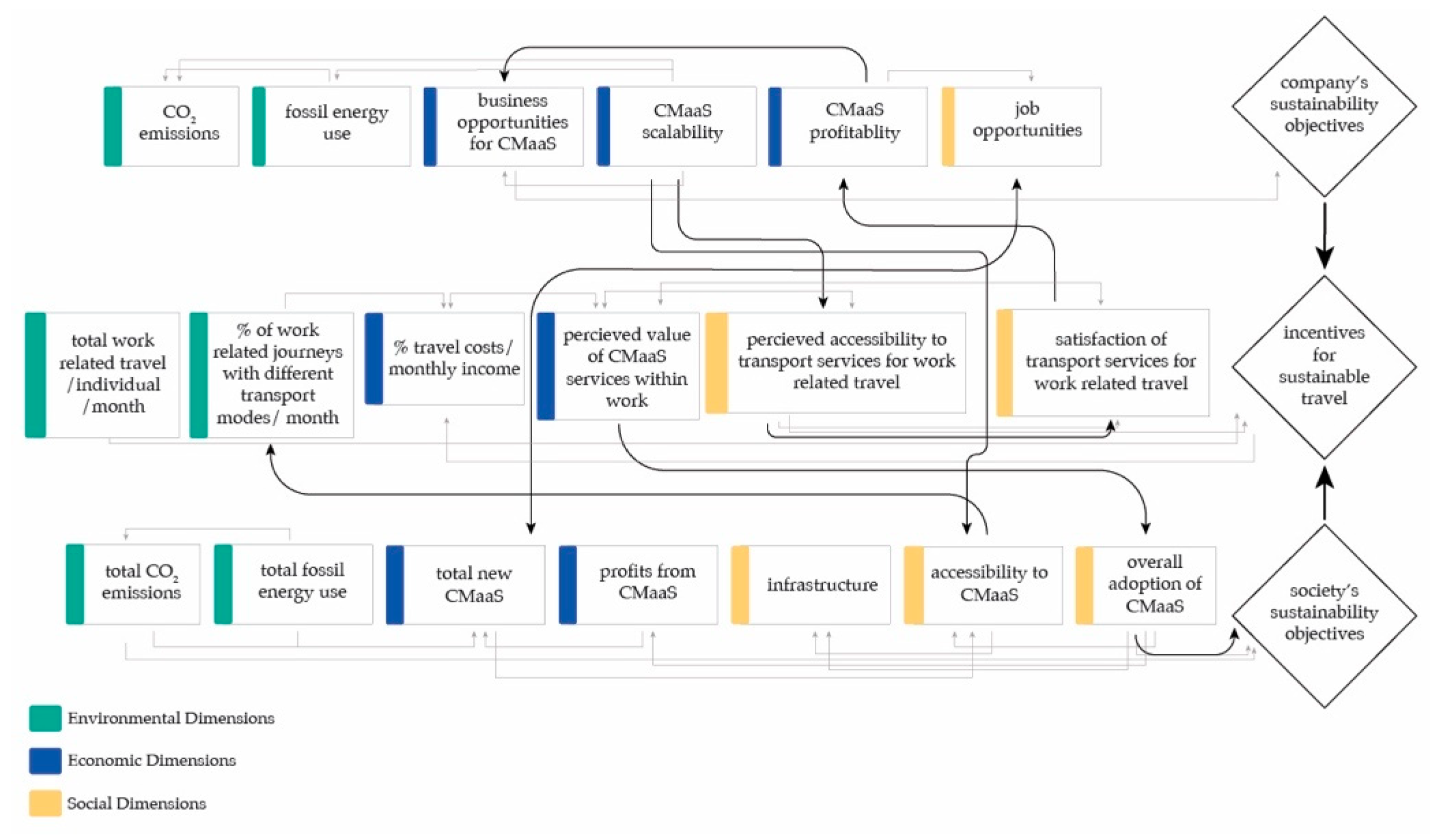
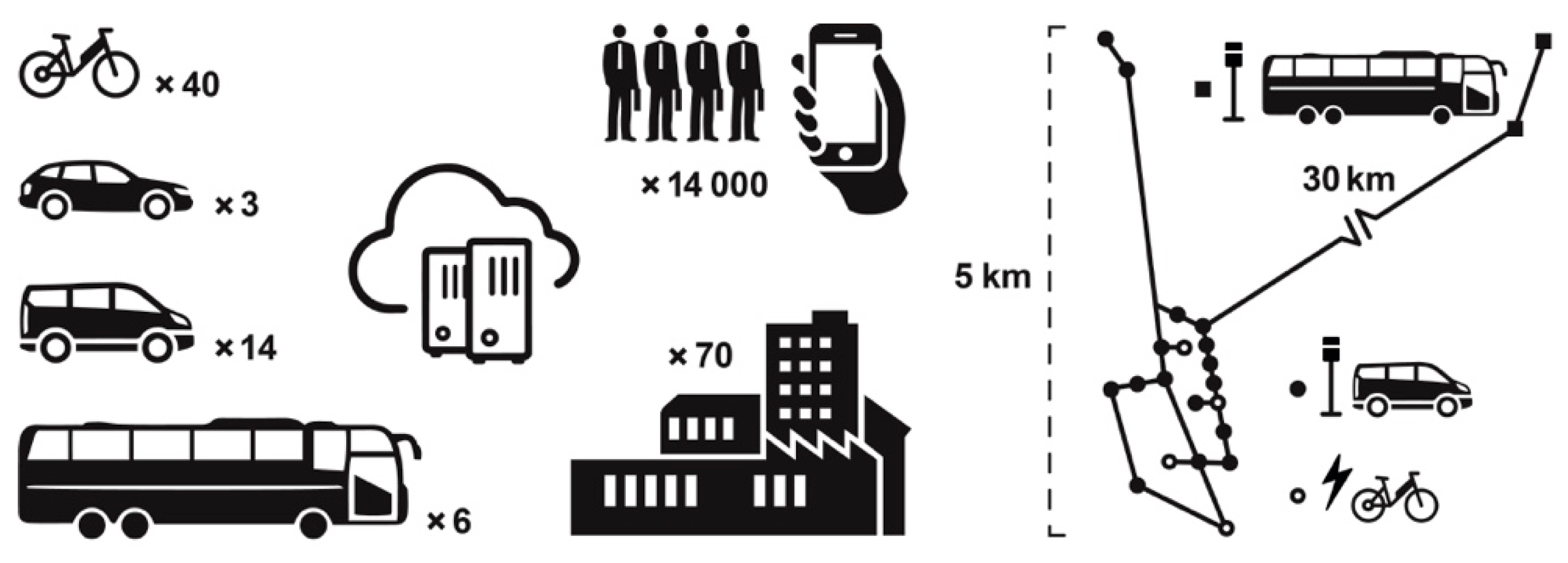
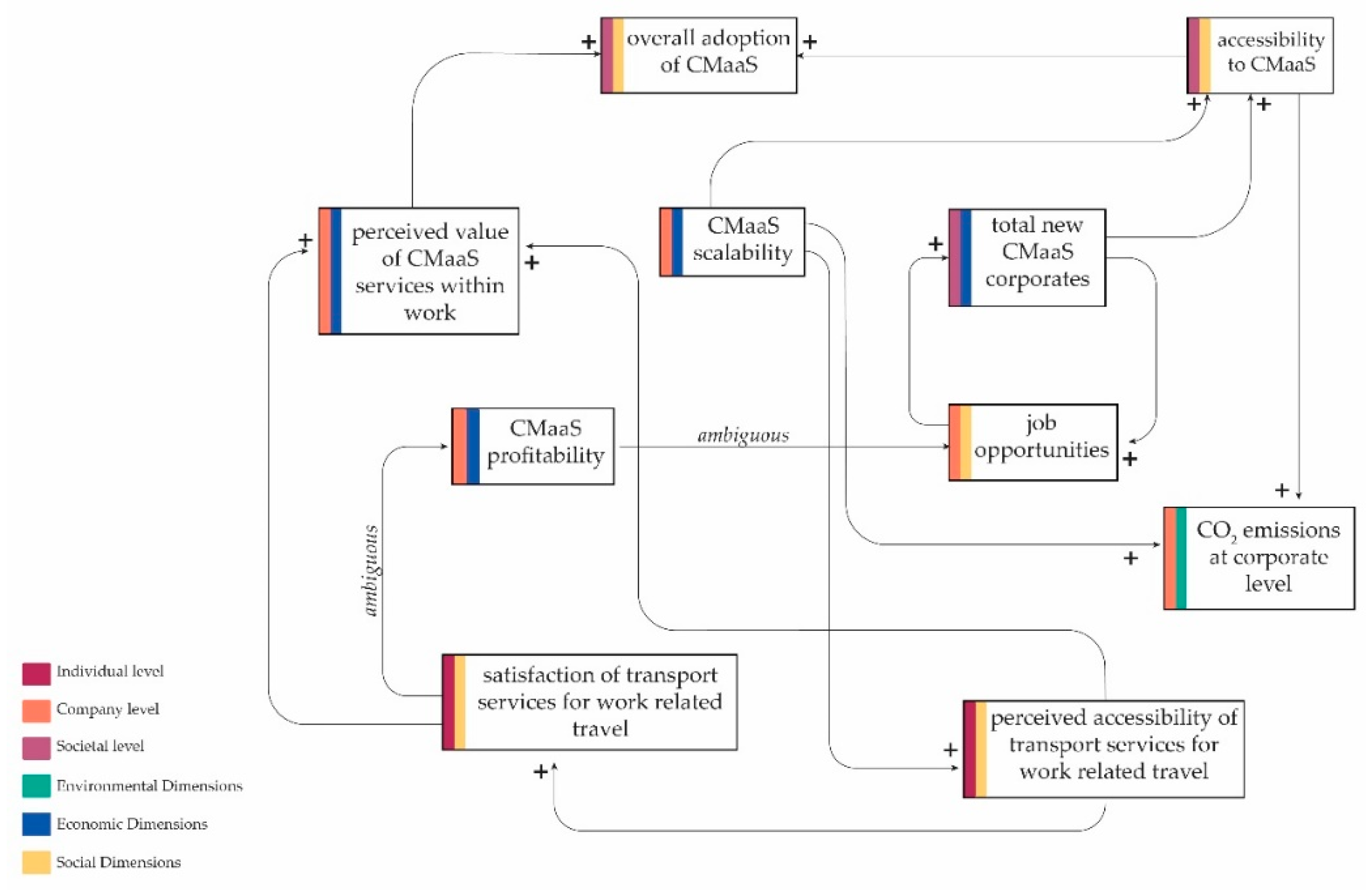
| Category of Indicators | Description | References |
|---|---|---|
| Quality of travel | Value and experience of travel such as, comfort; reliability; flexibility; satisfaction |
|
| Travel Costs | Individual or household costs of travel |
|
| Accessibility | Availability, access and distribution of facilities and services |
|
| Business Models | Effective business model indicators referring to type of value creation, economic profits, value offered to the customer, service pricing and management. |
|
| Employment | New job opportunities are created due to the transport service. |
|
| Quality of life | Influence of travel on functions of life for society and its individuals such as health, time use, recreation etc. |
|
| Infrastructure and Land use | Required area or costs for transport services such as bus stops, parking spaces, roads etc. and use of space |
|
| Travel behavior | Individuals’ travel preferences and habits such as kms travelled, no. of trips, choice of transport modes etc. |
|
| Energy use & Emissions | Consumption of fossil fuels of transportation & Pollution due to use of private vehicles for example: CO2 emissions affecting air quality due to petrol and diesel vehicles |
|
| Category of Indicators | KPI Values | Description | |
|---|---|---|---|
| Travel Behavior | total travel/individual/month | total number of trips that were made | |
| % of multimodal total no. of trips/individual/ month | number of multimodal trips combining the following traffic modes within one travel: Public transport CMaaS Services, Personal Car, Walk | ||
| Travel Costs | % travel costs/ monthly income | the total monthly cost of individual / household daily travel including: Cost of public transport ticket (s), Cost of car incl. gasoline, parking, Cost of car rental, Cost of taxi ride | |
| perceived value of services within work | to what extent the user perceives that the options provided by the transport system are worth the cost in SEK. | ||
| Accessibility | perceived accessibility to transport services for work related travel | to what extent the user’s needs for travel are fulfilled | |
| Quality of travel | satisfaction of transport services for work related travel | to what extent the user finds that the transport system is designed in a way that makes it easy to reach destinations | |
| Category of Indicators | KPI Values | Description | |
|---|---|---|---|
| Energy use & Emissions | CO₂ emissions | amount of CO₂ emissions per kilometer driven | |
| fossil energy use | amount of fossil fuel per kilometer driven | ||
| Business Models | business opportunities for CMaaS | to what extent the service leads to new business opportunities | |
| CMaaS scalability | assessing the ability of the company’s business model to cost-efficiently grow | ||
| CMaaS profitability | net profit margin, i.e. a ratio of total revenue minus costs divided by total revenue | ||
| Employment | job opportunities | to what extent the service can lead to new jobs | |
| Category of Indicators | KPI Values | Description | |
|---|---|---|---|
| Energy use & Emissions | total CO₂ emissions | total CO₂ emissions per kilometer driven | |
| total fossil energy use | total fossil energy use travel per year | ||
| Business Models | profits from CMaaS | total new employees are employed in companies / organizations related to CMaaS | |
| Employment | total new CMaaS corporates | taxes from CMaaS operation | |
| Infrastructure & Land Use | infrastructure | land area or cost used for bus stops, roads, electric charging points, parking lots, etc. | |
| Accessibility | accessibility to CMaaS | to what extent the service reaches different user segments and user groups | |
| Quality of travel | overall adoption of CMaaS | to what extent do users accept and adopt to the new CMaaS services | |
| Variable | Count (n = 422) | |
|---|---|---|
| Age | 20–29 | 69 |
| 30–39 | 117 | |
| 40–49 | 112 | |
| 50–59 | 104 | |
| 60–69 | 20 | |
| Gender | Male | 285 |
| Female | 137 | |
| Household Size | 1 | 78 |
| 2 | 123 | |
| 3 | 71 | |
| 4 | 120 | |
| 5 or more | 23 | |
| Access to driver’s license | Yes | 404 |
| No | 18 | |
| Access to car in the household | Yes | 346 |
| No | 76 | |
| Days/week at workplace | 1 | 2 |
| 2 | 0 | |
| 3 | 4 | |
| 4 | 23 | |
| 5 | 384 | |
| Travel Behaviour (transport alternatives normally used when commuting to/from work) | Private car as a driver | 280 |
| Private car as a passenger | 49 | |
| Commuter bus (offered by the company) | 59 | |
| Public Transport | 100 | |
| Own bike | 74 | |
| E-bike (offered by the company) | 4 | |
| Taxi (offered by the company) | 3 | |
| Shuttle bus (offered by the company) | 18 | |
| Walk | 38 | |
| Other | 10 | |
| Travel Behaviour (transport alternatives normally used when commuting within work) | Private car as a driver | 179 |
| Private car as a passenger | 47 | |
| Commuter bus (offered by the company) | 33 | |
| Public Transport | 13 | |
| Own bike | 31 | |
| E-bike (offered by the company) | 70 | |
| Taxi (offered by the company) | 53 | |
| Shuttle bus (offered by the company) | 262 | |
| Walk | 170 | |
| Other | 13 | |
| Variable | KPIs | KPI Values | |
|---|---|---|---|
| Individual | total work/related travel/individual/month | 26 | |
| % of work-related journeys with different transport modes/ month | Personal car as a passenger | 21% | |
| Taxi (offered by the company) | 6% | ||
| Shuttle bus (offered by the company) | 30% | ||
| Walk | 20% | ||
| Other | 15% | ||
| E-bike | 8% | ||
| Perceived accessibility to transport services for work related travel | 22% (overall) | ||
| Satisfaction of transport services for work related travel | App | 18% strongly satisfied | |
| Taxi (offered by the company) | 19% strongly satisfied | ||
| Shuttle bus (offered by the company) | 34% strongly satisfied | ||
| E-bike | 22% strongly satisfied | ||
| Organizational | CO2 emissions | 14.4 kgCO²/vehicle/month | |
| Fossil energy use | 5.47 liters/vehicle/month | ||
| CMaaS scalability | Level 2 | ||
| Job opportunities | 0.1% | ||
© 2020 by the authors. Licensee MDPI, Basel, Switzerland. This article is an open access article distributed under the terms and conditions of the Creative Commons Attribution (CC BY) license (http://creativecommons.org/licenses/by/4.0/).
Share and Cite
Vaddadi, B.; Zhao, X.; Susilo, Y.; Pernestål, A. Measuring System-Level Impacts of Corporate Mobility as a Service (CMaaS) Based on Empirical Evidence. Sustainability 2020, 12, 7051. https://doi.org/10.3390/su12177051
Vaddadi B, Zhao X, Susilo Y, Pernestål A. Measuring System-Level Impacts of Corporate Mobility as a Service (CMaaS) Based on Empirical Evidence. Sustainability. 2020; 12(17):7051. https://doi.org/10.3390/su12177051
Chicago/Turabian StyleVaddadi, Bhavana, Xiaoyun Zhao, Yusak Susilo, and Anna Pernestål. 2020. "Measuring System-Level Impacts of Corporate Mobility as a Service (CMaaS) Based on Empirical Evidence" Sustainability 12, no. 17: 7051. https://doi.org/10.3390/su12177051
APA StyleVaddadi, B., Zhao, X., Susilo, Y., & Pernestål, A. (2020). Measuring System-Level Impacts of Corporate Mobility as a Service (CMaaS) Based on Empirical Evidence. Sustainability, 12(17), 7051. https://doi.org/10.3390/su12177051







